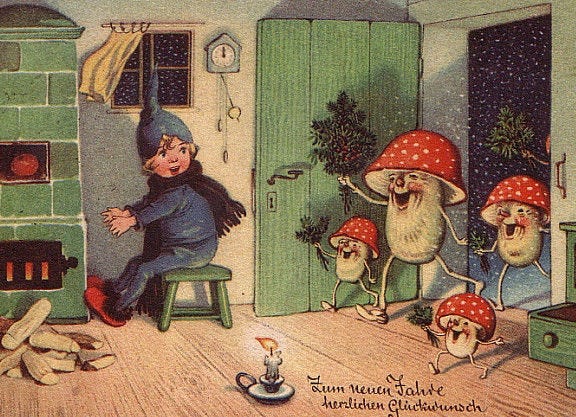By Mustapha Itani, Medium, December 1, 2018
One could trace the origin of the story of Santa Claus and Christmas tradition to several theories, the most famous one being the story of Saint Nicholas, a fourth-century Greek saint known for his generosity.
Another theory links Santa Claus’ red and white color scheme to a genius Coca-Cola advertising campaign. Yet, elements of Santa Claus’ tale and life, especially from the very popular ’Twas The Night Before Christmas’ poem recited every year by millions around the world, reveal a different story.
When one thinks of Christmas and this time of year, one immediately imagines the colors red and white, from the gift wraps to Christmas sweatshirts and of course Santa Claus famous red and white attire. A red and white scheme is clear in the context of this holiday and the traditions surrounding it.
Santa Claus’ archetypal image can be dated to hundreds if not thousands of years, even found in the most unpredictable places and times.
Since pre-Christian times, this time of year has always been a time of festivities and celebration, with music, dancing, banquets, and gatherings.
Germanic peoples, for example, had the Midwinter festival, Yule, which occurred around the Winter Solstice (21st December). Also, the Romans had the festival of Saturnalia, an ancient festival in honor of the god Saturn, held on the 17th of December through to the 23rd of December.
In the case of this article, we’ll be dealing with the Siberian and Arctic regions, where shamans dropped into locals’ homes with a bag full of magic mushrooms as presents in late December.
“Santa is a modern counterpart of a shaman, who consumed mind-altering plants and fungi to commune with the spirit world”, he says, “as the story goes, up until a few hundred years ago these practicing shamans or priests connected to the older traditions would collect Amanita muscaria (the Holy Mushroom), dry them, and then give them as gifts on the winter solstice,” according to John Rush, an anthropologist, and instructor at Sierra College.
Amanita muscaria is found throughout the Northern Hemisphere under conifers and birch trees, just like presents found under the Christmas tree by excited and happy children. This explains the tradition of the Christmas tree and the gifts, wrapped in red and white, placed under the tree just like the magic mushrooms.
Amanita muscaria is classified as poisonous, this might be a reason the shamans of that time initially hang the fresh Amanita muscaria to dry on tree branches, just like the colorful ornaments on a Christmas tree.

Santa’s flying reindeer have a similar connection to the Amanita muscaria mushrooms. Reindeer, in general, are common across Europe and Siberia, and just like the human inhabitants of these areas, they too consumed mushrooms. Harvard University biologist Donald Pfister suggests that Siberians who ingested the mushrooms may have hallucinated that the grazing reindeer were actually flying.
Research has shown that reindeer do in fact have a fondness for the Amanita Muscaria. Deputy editor of the Pharmaceutical Journal, Andrew Haynes, wrote in 2010 that animals deliberately seek out the red and white spotted mushroom in their habitats, as they “have a desire to experience altered states of consciousness” Haynes also wrote, “for humans, a common side-effect of mushrooms is the feeling of flying, so it’s interesting the legend about Santa’s reindeer is they can fly.”According to The Sun, Haynes even claimed that reindeer seek out the mushrooms to “escape the monotony of dreary long winters.”
“At first glance, one thinks it’s ridiculous, but it’s not,” said Carl Ruck, a professor of classics at Boston University. “Whoever heard of reindeer flying? I think it’s becoming general knowledge that Santa is taking a ‘trip’ with his reindeer.”
To add to things, Rudolf’s red nose might have been a representation of the Amanita muscaria, while the idea of helper elves assisting Santa in making children happy might go back to the spirits encountered by the shaman during a mushroom trip.

One historian, Ronald Hutton, told NPR that the theory of a mushroom-Santa connection is flawed. “If you look at the evidence of Siberian shamanism, which I’ve done,” Hutton said, “you find that shamans didn’t travel by sleigh, didn’t usually deal with reindeer spirits, very rarely took the mushrooms to get trances, didn’t have red-and-white clothes.”
Yet Rush and Ruck disagree. According to the two researchers, the shamans did actually deal with reindeer spirits and the ingestion of mushrooms is well documented. Siberian shamans did wear red deer pelts, but the coloring of Santa’s garb is mainly meant to mirror the coloring of Amanita mushrooms, Rush added. As for sleighs, the point is not the mode of travel, but that the “trip” involving the transportation to a different, celestial realm, Rush said. Sometimes people would also drink the urine of the shaman or the reindeer, as the hallucinogenic compounds are excreted this way, without some of the harmful chemicals present in the mushrooms, which are broken down by the shaman or the reindeer, according to Rush.
“People who know about shamanism accept this story,” Ruck said. “Is there any other reason that Santa lives in the North Pole? It is a tradition that can be traced back to Siberia.”
In conclusion, all theories of the origin of Christmas traditions could have some elements of truth, and with that said, this excerpt from James Arthur’s ‘Mushrooms and Mankind: The Impact of Mushrooms on Human Consciousness and Religion’ probably best summarizes the Santa magic mushroom theory.
“So, why do people bring Pine trees into their houses at the Winter Solstice, placing brightly colored (Red and White) packages under their boughs, as gifts to show their love for each other and as representations of the love of God and the gift of his Sons life? It is because, underneath the Pine bough is the exact location where one would find this ‘Most Sacred’ Substance, the Amanita muscaria, in the wild.”



No comments:
Post a Comment